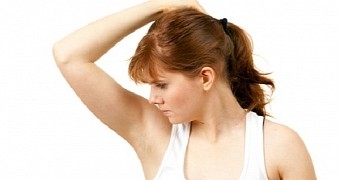Last week, we got to play the brainiacs and talked about how the stars that populate the cosmos birth light. The time has now come take a few minutes to discuss a more mundane matter: how deodorants and antiperspirants work.
These body fresheners, if we may be so bold as to call them by this name, come in all shapes, sizes and, most importantly, smells. The thing is that, although hundreds of thousands of people use them on a daily basis, few know how they work and what they contain.
First off, here’s what sweat is and why it smells
In this day and age, sweat is too often frowned upon. We hate it when our T-shirts and dresses get those nasty pit stains and we’re not exactly thrilled when, after a hard day’s work, we – for lack of a better word – stink.
The thing is that our body does not sweat because it hates us and wants to make our friends hate us as well. It sweats because it wants to cool off. Thus, the sweat that leaves our body absorbs heat energy and, in doing so, lowers our temperature.
What’s interesting is that, in itself, sweat has no scent. It’s bacteria living on our skin that give it its unpleasant smell when they start to feed on it. Seeing how sweat has a more difficult time evaporating from under our arms and insides shoes, our pits and feet are hit the hardest.
How deodorants and antiperspirants solve this problem
Now that we know why sweat smells, let’s turn our attention to how deodorants and antiperspirants deal with this problem. In a nutshell, both these body fresheners work by eliminating one of the two factors that make our armpits not so people-friendly.
Deodorants contain alcohol and several antimicrobial compounds. Together, these ingredients kill the bacteria living on our skin. By destroying these microorganisms, deodorants make sure our sweat does not get eaten up. As a result, our armpits stay fresh.
Antiperspirants, on the other hand, contain compounds that, when on the skin, create a thin coating that keeps our sweat glands from doing their job. Simply put, antiperspirants keep sweat from reaching the surface of our skin. Hence, the bacteria are left hungry.
Mind you, both deodorants and antiperspirants also pack ingredients that release pleasant odors and that help mask whatever unpleasant smells might be produced by surviving bacteria or by trace amounts of water that might make it through the protective layer.
Are antiperspirants and deodorants dangerous?
There are some who claim that, by keeping the body from sweating, antiperspirants prevent the release of toxins and cause them to build up in the organism. The thing is that the human body chiefly relies on the liver and on the kidneys to get rid of harmful compounds.
What this means is that, even if some toxins are not released through armpit sweat, there is no way this threatens the overall wellbeing of the human body. Thus, the toxins in question will surely find some other way out of the body.
Now, although it is true that some of the compounds found in antiperspirants and deodorants are not the most people-friendly in the world, scientists say that there is no reason to worry that they might make us sick. Thus, researchers say that there is no bullet-proof evidence that the use of deodorants and antiperspirants can prove harmful.
This observation concludes this week’s Freaky Friday Mystery. Be sure to check this page again next week as another piece in this series will surely be waiting for you.

 14 DAY TRIAL //
14 DAY TRIAL // 



